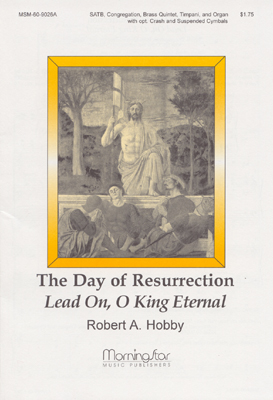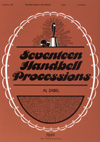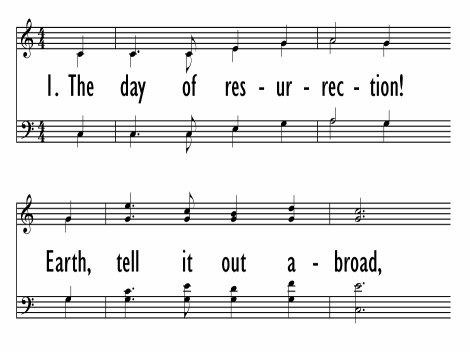- |
User Links
The Day of Resurrection

The day of Resurrection
Author: St. John of Damascus; Translator: J. M. NealePublished in 514 hymnals
Printable scores: PDFPlayable presentation: Lyrics only, lyrics + musicAudio files: MIDI, Recording
Representative Text
1 The day of resurrection!
Earth, tell it out abroad;
the passover of gladness,
the passover of God.
From death to life eternal,
from earth unto the sky,
our Christ hath brought us over,
with hymns of victory.
2 Our hearts be pure from evil,
that we may see aright
the Lord in rays eternal
of resurrection light;
and listening to his accents,
may hear, so calm and plain,
his own "All hail!" and, hearing,
may raise the victor strain.
3 Now let the heavens be joyful!
Let earth the song begin!
Let the round world keep triumph,
and all that is therein!
Let all things seen and unseen
their notes in gladness blend,
for Christ the Lord hath risen,
our joy that hath no end.
United Methodist Hymnal, 1989
Author: St. John of Damascus
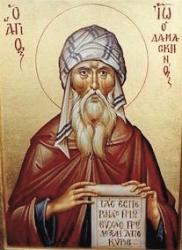 Eighth-century Greek poet John of Damascus (b. Damascus, c. 675; d. St. Sabas, near Jerusalem, c. 754) is especially known for his writing of six canons for the major festivals of the church year. John's father, a Christian, was an important official at the court of the Muslim caliph in Damascus. After his father's death, John assumed that position and lived in wealth and honor. At about the age of forty, however, he became dissatisfied with his life, gave away his possessions, freed his slaves, and entered the monastery of St. Sabas in the desert near Jerusalem. One of the last of the Greek fathers, John became a great theologian in the Eastern church. He defended the church's use of icons, codified the practices of Byzantine chant, and wr… Go to person page >
Eighth-century Greek poet John of Damascus (b. Damascus, c. 675; d. St. Sabas, near Jerusalem, c. 754) is especially known for his writing of six canons for the major festivals of the church year. John's father, a Christian, was an important official at the court of the Muslim caliph in Damascus. After his father's death, John assumed that position and lived in wealth and honor. At about the age of forty, however, he became dissatisfied with his life, gave away his possessions, freed his slaves, and entered the monastery of St. Sabas in the desert near Jerusalem. One of the last of the Greek fathers, John became a great theologian in the Eastern church. He defended the church's use of icons, codified the practices of Byzantine chant, and wr… Go to person page >Translator: J. M. Neale
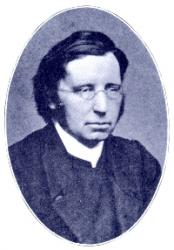 John M. Neale's life is a study in contrasts: born into an evangelical home, he had sympathies toward Rome; in perpetual ill health, he was incredibly productive; of scholarly temperament, he devoted much time to improving social conditions in his area; often ignored or despised by his contemporaries, he is lauded today for his contributions to the church and hymnody. Neale's gifts came to expression early–he won the Seatonian prize for religious poetry eleven times while a student at Trinity College, Cambridge, England. He was ordained in the Church of England in 1842, but ill health and his strong support of the Oxford Movement kept him from ordinary parish ministry. So Neale spent the years between 1846 and 1866 as a warden of Sackvi… Go to person page >
John M. Neale's life is a study in contrasts: born into an evangelical home, he had sympathies toward Rome; in perpetual ill health, he was incredibly productive; of scholarly temperament, he devoted much time to improving social conditions in his area; often ignored or despised by his contemporaries, he is lauded today for his contributions to the church and hymnody. Neale's gifts came to expression early–he won the Seatonian prize for religious poetry eleven times while a student at Trinity College, Cambridge, England. He was ordained in the Church of England in 1842, but ill health and his strong support of the Oxford Movement kept him from ordinary parish ministry. So Neale spent the years between 1846 and 1866 as a warden of Sackvi… Go to person page >Text Information
Related Texts
| First Line: | The day of Resurrection |
| Title: | The Day of Resurrection |
| Greek Title: | Άναστάσεως ήμέρα |
| Author: | St. John of Damascus |
| Translator: | J. M. Neale |
| Meter: | 7.6.7.6 D |
| Language: | English |
| Notes: | Spanish translation: See "En el glorioso día" by Federico J. Pagura |
| Copyright: | Public Domain |
- (hymns)
- (hymns)
- (hymns)
- (hymns)
- (hymns)
- (hymns)
- (hymns)
- (hymns)
- (hymns)
- (hymns)
- (hymns)
- (hymns)
- (hymns)
- (hymns)
- (hymns)
- (hymns)
- (hymns)
- (hymns)
- (hymns)
- (hymns)
- (hymns)
- (hymns)
- (hymns)
- (hymns)
- (hymns)
- (hymns)
- (hymns)
- (hymns)
- (hymns)
- (hymns)
- (hymns)
- (hymns)
- (hymns)
- (hymns)
- (hymns)
- (hymns)
- (hymns)
- (hymns)
- (hymns)
- Year A, Lent, Fifth Sunday
- Year A, Ordinary Time, Proper 6 (11)
This is recommended for Year A, Ordinary Time, Proper 6 (11) by 2 hymnal lectionary indexes including Glory to God: the Presbyterian Hymnal #233. - Year A, Ordinary Time, Proper 18 (23)
- Year B, Easter season, Easter Vigil
- Year B, Easter season, Easter Day
- Year C, Easter season, Second Sunday
Chinese
English
- A Church of England Hymn Book: adapted to the daily services of the Church throughout the year #183
- A Handy Book of Old and Familiar Hymns #70
- A Hymnal and Service Book for Sunday Schools, Day Schools, Guilds, Brotherhoods, etc. #224
- A Hymnal for Friends #146
- A New Hymnal for Sunday Schools #56
- A School Service Book #d160
- A Selection of Spiritual Songs: with music for the Church and the Choir #340
- A Service Hymn Book #d139
- A Treasury of Hymns, the Best-Loved Hymns, Carols ... #d236
- A. M. E. C. Hymnal #108 10 shown out of 382
Korean
Spanish
Notes
Scripture References:
st. 2 = Rev. 1:16, Matt. 28:9
st. 3 = Ps. 19:1, Ps. 150:6, John 16:22
See PHH 389 for information about the origins of this text and John of Damascus.
This text also comes from John's first ode of the "Golden Canon," recognized as his finest work and written around 750. It was traditionally sung at midnight on Easter with the lighting of candles.
John M. Neale's (PHH 342) rather free English translation was published in his Hymns of the Eastern Church (1862). The first stanza uses the Old Testament Passover story as a metaphor for Christ's resurrection (as is customary in all the first odes of a Greek canon). In stanza 2 we, like the New Testament disciples, become witnesses to the risen Lord. Stanza 3 invites the entire cosmos to join in praise to the risen Christ.
Liturgical Use:
Easter, but this marvelous text may be sung any Sunday.
--Psalter Hymnal Handbook, 1988
Tune
LANCASHIRE (Smart)Henry T. Smart (PHH 233) composed the tune in 1835 for use at a missions festival at Blackburn, Lancashire, England. For that festival, which celebrated the three-hundredth anniversary of the Reformation in England, the tune was set to Reginald Heber's (PHH 249) “From Greenland's Icy Mountains.”…
ROTTERDAM (Tours)
ELLACOMBE
Published in a chapel hymnal for the Duke of Würtemberg (Gesangbuch der Herzogl, 1784), ELLACOMBE (the name of a village in Devonshire, England) was first set to the words "Ave Maria, klarer und lichter Morgenstern." During the first half of the nineteenth century various German hymnals altered the…
For Leaders
Text:
The eighth-century Greek Church Father, John of Damascus, is well-known for his long Greek hymns called “canons.” Each canon had nine parts called “odes,” and this hymn is the first ode from the canon for Easter, called the “Golden Canon” or “Queen of Canons.” John Mason Neale translated the three stanzas of this ode into English and published it in his Hymns of the Eastern Church in 1862. The standard text has three stanzas, though a few hymnals add a doxological stanza as a fourth. The first stanza refers to the Passover account in Exodus 15. In the second, we express a desire to see the resurrected Lord. The third stanza is a call to all creation to celebrate the risen Christ.
Tune:
This hymn is most often sung to LANCASHIRE, which was written in 1835 by Henry T. Smart for the 300th anniversary of the Reformation in England. It was originally printed in leaflets with Reginald Heber's text, “From Greenland's Icy Mountains,” for the October 4 celebration service in Blackburn, Lancashire. Many years later, in 1867, Smart published it in his Psalms and Hymns for Divine Worship in London. LANCASHIRE is a strong tune that somewhat resembles a march. For a jubilant text such as this one, use bright tone colors in the accompaniment, such as trumpets or the brighter registers of the organ.
Another well-known tune frequently used for this text is ELLACOMBE, an anonymous tune with German Roman Catholic origins. A tune with some resemblance to our modern one was published in 1784 in a chapel hymnal for the Duke of Württemberg. Various German hymnals published other variants during the early nineteenth century. The Vollständige Sammlung der gewöhnlichen Melodien zum Mainzer Gesangbuche, published in Mainz in 1833, has a version much closer to the modern one. This tune reached the English-speaking world through the 1868 appendix to Hymns Ancient and Modern, in an arrangement by W. H. Monk. ELLACOMBE is the name of a village in Devonshire, England, but any connection between the village and the tune is unknown. This tune is joyful and buoyant, and works well when sung in harmony.
When/Why/How:
Though this splendid hymn could be sung any Sunday, it is best suited to Easter Sunday, especially as a prelude or opening hymn. As a prelude on Easter Sunday, try an organ and handbell arrangement, such as "Festival Prelude on LANCASHIRE," which combines that hymn tune and Eugène Gigout's "Grand Choeur Dialogué." For the opening hymn, the joy of the Resurrection almost demands full participation by the choir, congregation, and accompanying instruments. A grand setting of “The Day of Resurrection” to the tune LANCASHIRE is for choir and congregation, accompanied by organ, brass, and timpani, with optional cymbals. The fourth stanza is a majestic doxology. A concertato arrangement of ELLACOMBE for “The Day of Resurrection” features brass and organ accompaniment for choral and congregational singing.
Tiffany Shomsky, Hymnary.org
Timeline
Arrangements
Media
Psalter Hymnal (Gray) #390
The United Methodist Hymnal #303
- MIDI file from Baptist Hymnal 1991 #164
- MIDI file from Baptist Hymnal 1991 #164
- MIDI file from Carols Old and Carols New: for use at Christmas and other seasons of the Christian year #159
- MIDI file from The Cyber Hymnal #1173
- Audio recording from Evangelical Lutheran Worship #361
- Audio recording from Glory to God: the Presbyterian Hymnal #233
- MIDI file from Psalter Hymnal (Gray) #390
- MIDI file from Psalter Hymnal (Gray) #390
- MIDI file from The United Methodist Hymnal #303
- Audio recording from The United Methodist Hymnal #303
- MIDI file from Worship and Rejoice #298


 My Starred Hymns
My Starred Hymns